纺织英语第三版课文翻译Lesson Twelve-Yarns
纺织英语第三版课本知识中文翻译

Lesson Two Cotton Properties and UsesA relatively high level of moisture absorption and good wicking properties help make cotton one of the more comfortable fibers. Because of the hydroxyl groups in the cellulose, cotton has a high attraction for water. As water enters the fiber, cotton swells and its cross section becomes more rounded. The high affinity for moisture and the ability to swell when wet allow cotton to absorb about one-fourth of its weight in water. This means that in hot weather perspiration from the body will be absorbed in cotton fabrics, transported along the yarns to the outer surface of the cloth and evaporated into the air. Thus, the body will be aided in maintaining its temperature.相对较好的吸湿性和良好的芯吸性使棉纤维成为最舒适的纤维之一。
因为纤维素的羟基基团,使得棉花对水有很强的吸引力。
当水进入纤维棉,棉开始膨胀,其截面变得更圆。
这种高度的亲水性和潮湿时溶胀的性能使棉花可吸水达到其重量的1/4左右。
纺织英语第三版课后单词总结 (1~19课)
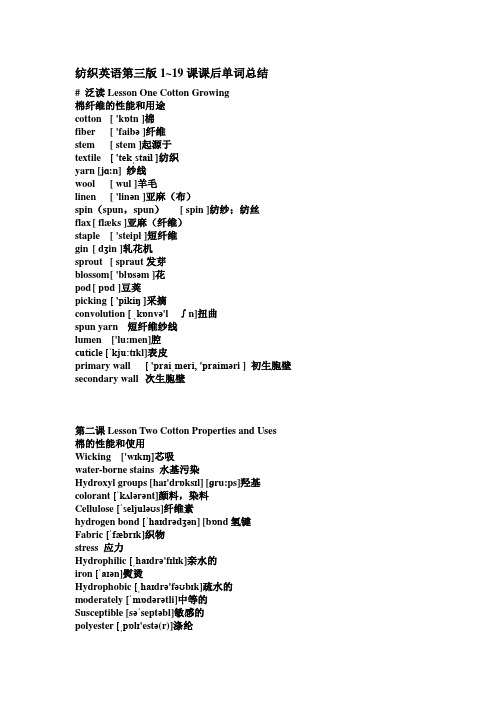
纺织英语第三版1~19课课后单词总结# 泛读Lesson One Cotton Growing棉纤维的性能和用途cotton [ 'kɒtn ]棉fiber [ 'faibə ]纤维stem [ stem ]起源于textile [ 'tekˌstail ]纺织yarn [jɑ:n] 纱线wool [ wul ]羊毛linen [ 'linən ]亚麻(布)spin(spun,spun)[ spin ]纺纱;纺丝flax [ flæks ]亚麻(纤维)staple [ 'steipl ]短纤维gin [ dʒin ]轧花机sprout [ spraut发芽blossom [ 'blɒsəm ]花pod [ pɒd ]豆荚picking [ 'pikiŋ ]采摘convolution [ ˌkɒnvə'l∫n]扭曲spun yarn 短纤维纱线lumen ['lu:men]腔cuticle [ˈkju:tɪkl]表皮primary wall [ 'praiˌmeri, 'praiməri ] 初生胞壁secondary wall 次生胞壁第二课Lesson Two Cotton Properties and Uses棉的性能和使用Wicking ['wɪkɪŋ]芯吸water-borne stains 水基污染Hydroxyl groups [haɪ'drɒksɪl] [ɡru:ps]羟基colorant [ˈkʌlərənt]颜料,染料Cellulose [ˈseljuləʊs]纤维素hydrogen bond [ˈhaɪdrədʒən] [bɒnd氢键Fabric [ˈfæbrɪk]织物stress 应力Hydrophilic [ˌhaɪdrə'fɪlɪk]亲水的iron [ˈaɪən]熨烫Hydrophobic [ˌhaɪdrə'fəʊbɪk]疏水的moderately [ˈmɒdərətli]中等的Susceptible [səˈseptəbl]敏感的polyester [ˌpɒlɪ'estə(r)]涤纶Organic solvent 有机溶剂homey 家庭般的Mold 霉菌mainstay [ˈmeɪnsteɪ]主要力量Fungus 真菌no-iron 免烫Prominent 突出的,显著地pillowcase枕套Mildew 发霉crisp 挺爽Degradation 降解smother 窒息Gas dryer 煤气烘干机stuff 闷热的,窒息的Impart 给予interstice 空隙Flexibility 挠性canvas gear 帆布用具Apparel 服装supplant 取代,替代Home furnishings 家居装饰cord 绳索Recreational 休闲的twine 细绳Pliable 柔顺的lash 捆绑Garment 服装bale 大包Shrink-resistant finish 防缩整理Blending 混纺# 泛Lesson Three Properties of the Naturally Colored Cottons 天然彩棉的性质disposal [ di'spəuzl ]处理,排放drainage [ 'dreinidʒ ]污水mercerize ['mɜ:səraɪz]丝光处理pesticide [ 'pestiˌsaid ]杀虫剂weed killer [wi:d]除草剂deposit [ di'pɒzit ]存留,囤积organic fertilizer [ɔ:ˈgænɪk] [ˈfɜ:təlaɪzə(r)]有机肥environmentally friendly 环境友好地breed 育种,品种color intensity [ in'tensəti ]颜色强度plantation [ plæn'tei∫n ]农场lignin [ 'lignin ]木质素pectin [ 'pektin ]果胶hydrophobic [ ˌhaidrə'fəubik]疏水的deteriorate [dɪˈtɪəriəreɪt]损害hue [hju:]色彩# 泛Lesson Four Wool 羊毛antiquity [ æn'tikwəti ]古代felt [ felt ]毡,制毡prehistoric [ ˌpr hi'st rik]史前的weave [wi:v]机织,织造;做名woolen goods 粗纺毛织物scouring [ skaur ]洗毛merino sheep [məˈri:nəʊ]美利奴羊worsted fabric [ˈwʊstɪd]精纺毛织物wavy [ 'weivi ]卷曲的inoculate [ i'nɒkjəˌleit ]给接种,给注射rangeland [ 'reindʒˌlænd ]放牧场fleece [fli:s]套毛clip wool [ klip ]套毛pulled wool [ pul ]皮板毛depilatory [dɪˈpɪlətri]脱毛剂preliminary grading [ˈgreɪdɪŋ]预分等,初级分等mill [mɪl]纺织厂decompose [ˌdi:kəmˈpəʊz]分解mineral acid [ˈmɪnərəl]无机酸Lesson Five Structure and Properties of Wool羊毛的结构和性能microscopic 显微镜的commmendable值得赞扬的scale 鳞片regain恢复magnification 放大倍数crushing挤压horny角状的durable crease耐久皱褶cuticle角质层Pleat皱褶打褶cortex角质皮质cross- linkage交键cortical cell角质细胞皮质细胞poiymer高聚物medulla毛髓loft蓬松的高雅的authoraty权威机构上级机关moisture regain回潮率pigment颜料染料covering power覆盖系数micron微米desportion水分释放kemp死毛hygroscopic吸湿的elliptical椭圆形的finish织物的整理oval卵形的椭圆形的interfacial界面的felting毡化silky像蚕丝一样的yellowish-white稍微发黄的白色# 精Lesson Six Silk 丝sericulture ['serɪˌkʌltʃə]养蚕业,蚕丝业AD 公元silkworm [ˈsɪlkwɜ:m]蚕reeling ['ri:lɪŋ]缫丝,络丝cocoon [kəˈku:n]蚕茧prestige [pre'sti:ʒ]声望;名声luxury [ˈlʌkʃəri]华贵的queen of fiber 纤维皇后denier [ˈdeniə(r)]旦尼尔specific gravity 相对密度moth [mɒθ] 蛾metal salts [ˈmetl]金属盐;无机盐sputter [ˈspʌtə(r)]噼啪爆响cellulosic fiber [seljʊ'ləʊsɪk] 纤维素纤维solubility [ˌsɒljʊ'bɪlətɪ] 溶解性ammonia [əˈməʊniə] 氨水concentration [ˌkɒnsnˈtreɪʃn] 浓度fibroin ['faɪbrəʊɪn]丝心蛋白keratin [ˈkerətɪn]角蛋白scroop [skru:p]丝鸣# 精Lesson seven Flax亚麻bast fiber [bæst]韧皮纤维woody [ˈwʊdi]木质的phloem [ˈfləʊem]韧皮stalk [stɔ:k]茎stem [stem]茎,针杆temperate [ˈtempərət]温和的intact [ɪnˈtækt]未经触动的rip [rɪp]剥boll [bəʊl]植物的铃rot 腐烂retting ['retɪŋ]沤麻dew retting [dju:]露水沤麻pool retting 池塘沤麻sheaves [ʃi:vz] sheaf的复数形式捆,束stagnant [ˈstægnənt]不流动的,污浊的bacteria[bækˈtɪəriə] bacterium的复数形式细菌tank retting 池浸沤麻sodium hydroxide 氢氧化钠sodium carbonate [ˈsəʊdiəm [ˈkɑ:bəneɪt]碳酸钠dilute sulfuric acid 稀硫酸fluted roller 沟槽罗拉scutch [skɒtʃ]打麻hackle ['hækl]梳麻comb [kəʊm] 梳理(精梳)tow [təʊ] 短纤维,短麻,落纤line [laɪn]长纤维,长麻sliver [ˈslɪvə(r)] 条子,棉条,毛条,纤维条carding ['kɑ:dɪŋ]梳理(粗梳)choice fiber 上等纤维sheen [ʃi:n] 光彩,光泽resin finish [ˈrezɪn]树脂整理easy care [ʃi:n]免烫,洗可穿serviceability [sɜ:vɪsə'bɪlɪtɪ]耐用性能wicking property 芯吸效应discoloration [disˌkʌləˈreiʃən]脱色beetling finish ['bi:tlɪŋ]捶布整理laundry aids [ˈlɔ:ndri] 洗涤剂aging 老化durable-press 耐久压烫,耐久定形,免烫整理,DP整理# 泛Lesson Eight Other Bast Fibers其他韧皮纤维jute [dʒu:t]黄麻burlap [ˈbɜ:læp]粗麻布hessian [ 'he∫n ]打包麻布grayish color [ˈgreɪɪʃ]泛灰的颜色fibrous [ˈfaɪbrəs]纤维状的gummy [ 'gʌmi ]黏稠的beige [ beiʒ ]米色microorganism [ˌmaɪkrəʊ'ɔ:gənɪzəm]微生物bagging ['bægɪŋ]打包布,马岱布carpet backing [ˈkɑ:pɪt]地毯底布,地毯背衬taping [teɪpɪŋ] 贴边linoleum [lɪˈnəʊliəm]漆布olefine ['əʊləfɪn]烯烃labor-intensive [ˈleibəinˈtensiv]劳动密集型ramie ['ræmɪ] 苎麻nettle [ˈnetl]荨麻family [ˈfæməli](植物的)科,类perennial [pəˈreniəl]多年生的shrub [ʃrʌb] 灌木necessitate 需要degum [nəˈsesɪteɪt]脱胶pectin [ˈpektɪn]果胶neutralize [ˈnju:trəlaɪz]中和crystallinity [,kristə'linəti]结晶度accessibility [əkˌsesə'bɪlətɪ]可及杜nonfibrous [nɒn'ferəs]非纤维状的hemp [hemp]大麻deplete [dɪˈpli:t]耗尽nutrient [ˈnju:triənt]营养的,营养品stripping 搏麻drawing [ˈdrɔ:ɪŋ]牵伸cordage ['kɔ:dɪdʒ]绳索sacking [ˈsækɪŋ]麻第九课Lesson Nine Rayon 人造丝Rayon黏胶,人造纤维Degree of polymerization聚合度Degree of crystallinity结晶度Infrared spectrum红外光谱Native cellulose天然纤维Regenerated cellulose再生纤维素Mechanism机理Morphologically形态方面的Contaminant污染物Pulp浆粕Molecular orientation分子取向Viscose黏胶Mode方式Amorphous area非结晶区Dyeability染色性能Striation条纹Delustered消光的Bilobal双叶形的High wet-modulus高湿模量Off round偏离圆形Cuprammonium rayon铜氨人造丝Surgical外科用Wipe擦试用品Limp松软Textured yarn变形纱Acrylic腈纶Reactant反应物Starch淀粉Softener柔软剂Hypochlorite次氯酸盐Peroxide bleach过氧化物漂白剂Dyestuff 染料第十课Lesson Ten Polyester Fibers聚酯纤维DuPont 杜邦公司polyamide 聚酰胺纤维ICI(Imperial Chemical Industries Limited)英国帝国化学工业公司Dacron 大可纶drawing process 牵伸过程heat stabilization 热定型static electric charge 静电accentuate 强调,突出heat-set 热定形pilling 起球protective clothing 防护服fire hose 消防水管tire cord 轮胎帘子布per-capita 人均implant 移植allergenic 过敏的drip-dried 滴水晾干11课Lesson Eleven Fiber Identification纤维鉴定Qualitative identification 定性鉴别staining 沾污,沾色Tentativeiy 试验性地refractive index 折射率Verify 证实index of birefringence 双折射率Unravel 拆散X-ray diffraction machine X光衍射仪Forceps 镊子infrared spectrophotometer 红外分光光度计Residue 残渣chromatograph 色谱仪Fluffy 毛茸茸的polarizing microscope 偏振光显微镜Photomicrograph 显微镜照片12课Lesson Twelve Yarns 纱Align 排成一排Roving 粗纱Assembly 集合体Plied yarn 合股线Cable 粗绳索Hawser 缆Forefinger 食指Medieval 中世纪的Untwist 退捻Curl 卷曲Kink 扭结Weaver 织布工人,织造工作者Middle age 中世纪Yarn number 纱线细度Yarn count 纱线支数,纱线线密度Nomenclature 名称术语Hank 纱绞Spun-silk 绢丝Yarn size 纱线支数,纱线细度Tex 特克斯Lesson Thirteen Relationship between Yarn Structure and Fabric Performance 纱线结构和性能间的关系crimp 英[krɪmp] 卷曲scatter 英['skætə(r)] 消散Overtwist英['əʊvətwɪst]强捻ridge 英[rɪdʒ]凸棱concomitant英[kən'kɒmɪt(ə)nt]伴随的bulk 英[bʌlk]蓬松的tweed 英[twiːd]粗花呢jacket 英['dʒækɪt]夹克bulky 英['bʌlkɪ] 粗大的,肥壮的blouse 英['blaʊz] 女衬衫,罩衫barrier英['bærɪə]阻挡层sultry 英['sʌltrɪ] 闷热的clammy英['klæmɪ黏糊糊的hairiness ['hɛrɪnɪs] 毛羽shed soil 英[ʃed sɒɪl阻挡尘土snag 英[snæg] 钩丝unsightly 英[ʌn'saɪtlɪ]不雅观的texture 英['tekstʃ质地slick英[slɪk] 滑溜溜的fuzzy 英['fʌzɪ] 毛茸茸的pajamas 英[pə'dʒɑːməz] 睡衣Acetate fiber 英['æsɪteɪt 'faɪbɚ]醋酯纤维satin 英['sætɪn]经面缎纹highlight 英['haɪlaɪt重点突出lining英['laɪnɪŋ]衣服衬里disrobe 英[dɪs'rəʊb]脱衣diffuse英[dɪ'fjuːz] 扩散,漫射第十四课Lesson Fourteen Staple Fiber Spinning(1)短纤维纺纱opening 开松cleaning 除杂carton 纸板箱opener 开棉机,开松机blender 混棉机,混合机intermittent system 间歇式纺纱系统spike 置凸钉apron 皮圈,皮板输送带lattice 输送帘子hopper 料斗,棉箱conveyor belt 传送带picking unit 清棉装置picker 清棉机forced air 高压气流picker lap 清棉棉卷card unit 梳理机构ring-spun yarn 环锭纱tuft 簇,团carding frame 梳棉机,梳理机drawing frame 并条机wire card 钢丝梳棉机granular card 无盖板梳棉机,微粒梳棉机card clothing 针布wire flat 盖板tease 梳理cylinder 锡林,滚筒doff 落卷,落筒can 条筒combed yarn 精梳机carded 粗梳机breaker-drawing 头道并条15课Lesson Fifteen Staple Fiber Spinning(2) Roller 罗拉roving frame 粗纱机Lapper 成网机,成网机构attenuate 使变细Comber 精梳机bobbin筒管Finisher-drawing 末道并条spinning frame 细纱机Assemblage 集合体ring spinning 环锭纺纱Draft 牵伸spindle 锭子Traveler 钢丝圈single 单纱Ring 钢领,环状,环形物# 泛Lesson Sixteen Textured Yarn膨松纱slippery [ˈslɪpəri]滑溜溜的(但没有弹性)full 丰满的handle [ˈhændl]手感linear density [ˈlɪniə(r)] [ˈdensəti]线密度extensibility [ɪksˌtensə'bɪlɪtɪ]伸展性bending stiffness ['bendɪŋ] [stɪfnəs]弯曲刚度disposition [ˌdɪspəˈzɪʃn]布置thermosetting ['θɜ:məʊˌsetɪŋ]热定型kont-free 无结complement [ˈkɒmplɪment]补充cover factor 覆盖系数offset [ˈɒfset]抵消stretch yarn 弹力丝,弹力纱false twist [fɔ:ls] [twɪst]假捻bulked yarn [bʌlk]膨体纱carpet [ˈkɑ:pɪt] 地毯,毛毯hosiery [ˈhəʊziəri]针织品,袜类stuffer-box 填塞箱air-jet 气流Lesson Seventeen Open-end Spinning自由端纺纱open-end spinning自由端纺纱,转杯纺纱warping ['wɔ:pɪŋ]整经synonym [ˈsɪnənɪm] 同义词fiber migration纤维迁移break spinning 自由端纺纱,转杯纺纱technique 差异染色技术rotor spinning 转杯纺纱spinning 涡流纺纱sieve 筛网wash-and-wear 洗可穿rotor 纺纱杯# 泛Lesson Eighteen Some specially Formed Yarns特殊成纱friction spinning [ˈfrɪkʃn [ˈspɪnɪŋ]摩擦纺纱DREF spinning 德雷夫纺纱法,尘笼纺body 身骨self-twisted yarn 自捻纱selfil yarn 加长丝自捻纱twistless yarn 无捻纱core-spun yarn 包芯纱spandex ['spændeks氨纶,斯潘德克斯弹性纤维coverspun 包绕纺纱bicomponent ['bɪkəmp'əʊnənt]双组分supple [ˈsʌpl]柔软的# 泛Lesson Nineteen Stretch Yarns and Fabrics弹力丝和织物terminology [ˌtɜ:mɪˈnɒlədʒi]术语,专用名词elastomeric [ɪˌlæstə'merɪk]弹性的braid [breɪd]编织foundation garment [ˈgɑ:mənt]全帮,内衣surgical supplies [ˈsɜ:dʒɪkl] [səp'laɪz]外科手术用织物knife-edge 刀口back twisting 反向加捻cross-linking resin 交联树脂kinky ['kɪŋkɪ]纽结的springy [ˈsprɪŋi]有弹性的cellulose eater [ˈseljuləʊs] [ˈi:tə(r)]纤维素酯cellulose ether [ˈi:θə(r)]纤维素醚thermoplastic [ˌθɜ:məʊˈplæstɪk]热塑性的knotting ['nɒtɪŋ]打结,编结piece-goods stretch 匹布加弹slipcover ['slɪpˌkʌvə]家具套,沙发套therapeutic [ˌθerəˈpju:tɪk]治疗的support hose [səˈpɔ:t həuz]管状弹性绷带。
纺织英语第三版课文翻译
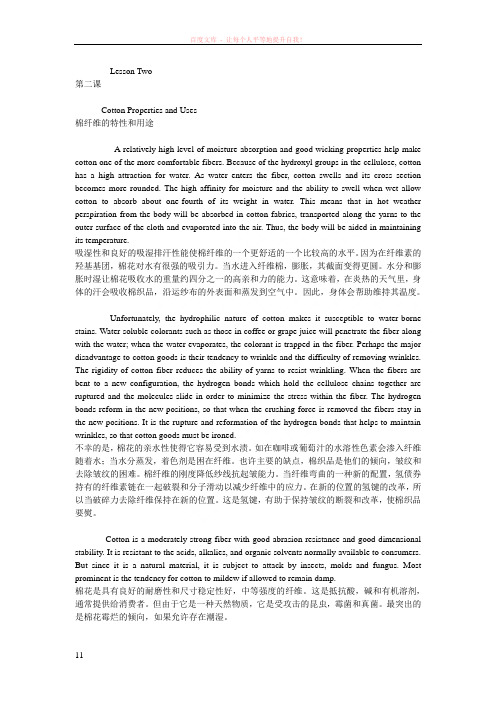
Lesson Two第二课Cotton Properties and Uses棉纤维的特性和用途A relatively high level of moisture absorption and good wicking properties help make cotton one of the more comfortable fibers. Because of the hydroxyl groups in the cellulose, cotton has a high attraction for water. As water enters the fiber, cotton swells and its cross section becomes more rounded. The high affinity for moisture and the ability to swell when wet allow cotton to absorb about one-fourth of its weight in water. This means that in hot weather perspiration from the body will be absorbed in cotton fabrics, transported along the yarns to the outer surface of the cloth and evaporated into the air. Thus, the body will be aided in maintaining its temperature.吸湿性和良好的吸湿排汗性能使棉纤维的一个更舒适的一个比较高的水平。
因为在纤维素的羟基基团,棉花对水有很强的吸引力。
当水进入纤维棉,膨胀,其截面变得更圆。
水分和膨胀时湿让棉花吸收水的重量约四分之一的高亲和力的能力。
纺织英语第三版课文中文翻译
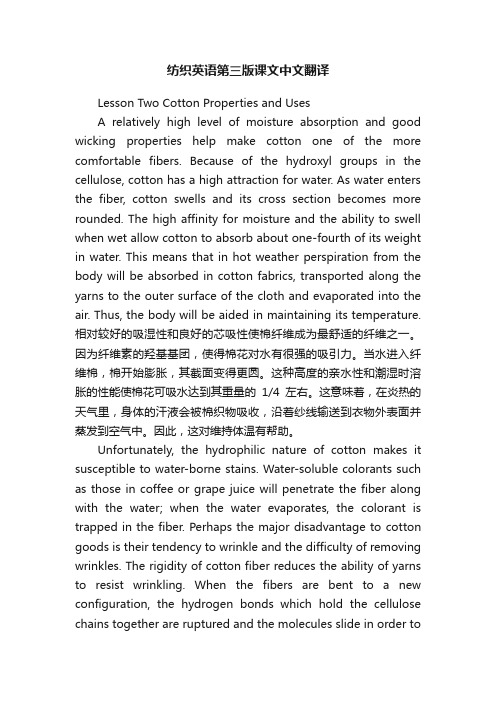
纺织英语第三版课文中文翻译Lesson Two Cotton Properties and UsesA relatively high level of moisture absorption and good wicking properties help make cotton one of the more comfortable fibers. Because of the hydroxyl groups in the cellulose, cotton has a high attraction for water. As water enters the fiber, cotton swells and its cross section becomes more rounded. The high affinity for moisture and the ability to swell when wet allow cotton to absorb about one-fourth of its weight in water. This means that in hot weather perspiration from the body will be absorbed in cotton fabrics, transported along the yarns to the outer surface of the cloth and evaporated into the air. Thus, the body will be aided in maintaining its temperature.相对较好的吸湿性和良好的芯吸性使棉纤维成为最舒适的纤维之一。
因为纤维素的羟基基团,使得棉花对水有很强的吸引力。
当水进入纤维棉,棉开始膨胀,其截面变得更圆。
这种高度的亲水性和潮湿时溶胀的性能使棉花可吸水达到其重量的1/4左右。
纺织英语第三版课文翻译-Rayon
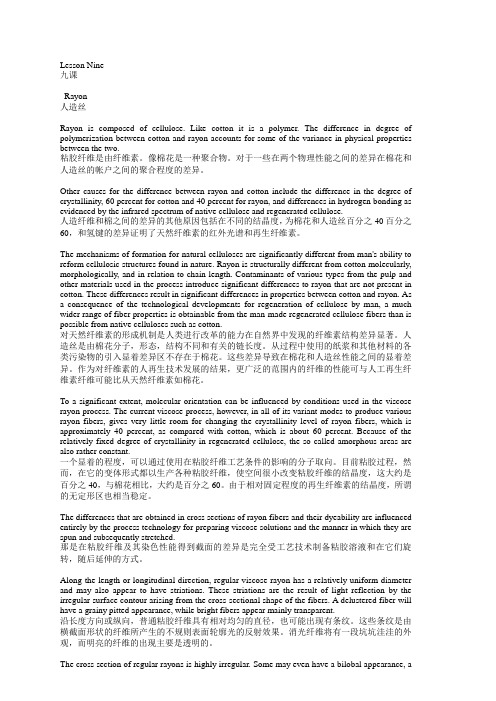
Lesson Nine九课Rayon人造丝Rayon is composed of cellulose. Like cotton it is a polymer. The difference in degree of polymerization between cotton and rayon accounts for some of the variance in physical properties between the two.粘胶纤维是由纤维素。
像棉花是一种聚合物。
对于一些在两个物理性能之间的差异在棉花和人造丝的帐户之间的聚合程度的差异。
Other causes for the difference between rayon and cotton include the difference in the degree of crystallinity, 60 percent for cotton and 40 percent for rayon, and differences in hydrogen bonding as evidenced by the infrared spectrum of native cellulose and regenerated cellulose.人造纤维和棉之间的差异的其他原因包括在不同的结晶度,为棉花和人造丝百分之40百分之60,和氢键的差异证明了天然纤维素的红外光谱和再生纤维素。
The mechanisms of formation for natural celluloses are significantly different from man's ability to reform cellulosic structures found in nature. Rayon is structurally different from cotton molecularly, morphologically, and in relation to chain length. Contaminants of various types from the pulp and other materials used in the process introduce significant differences to rayon that are not present in cotton. These differences result in significant differences in properties between cotton and rayon. As a consequence of the technological developments for regeneration of cellulose by man, a much wider range of fiber properties is obtainable from the man-made regenerated cellulose fibers than is possible from native celluloses such as cotton.对天然纤维素的形成机制是人类进行改革的能力在自然界中发现的纤维素结构差异显著。
纺织英语第三版课文翻译Lesson TwentyFive-Yarn Winding
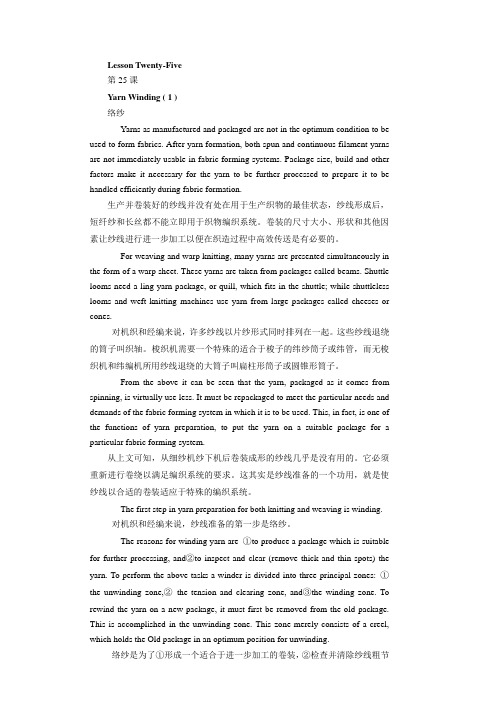
Lesson Twenty-Five第25课Yarn Winding ( 1 )络纱Yarns as manufactured and packaged are not in the optimum condition to be used to form fabrics. After yarn formation, both spun and continuous filament yarns are not immediately usable in fabric forming systems. Package size, build and other factors make it necessary for the yarn to be further processed to prepare it to be handled efficiently during fabric formation.生产并卷装好的纱线并没有处在用于生产织物的最佳状态,纱线形成后,短纤纱和长丝都不能立即用于织物编织系统。
卷装的尺寸大小、形状和其他因素让纱线进行进一步加工以便在织造过程中高效传送是有必要的。
For weaving and warp knitting, many yarns are presented simultaneously in the form of a warp sheet. These yarns are taken from packages called beams. Shuttle looms need a ling yarn package, or quill, which fits in the shuttle; while shuttleless looms and weft knitting machines use yarn from large packages called cheeses or cones.对机织和经编来说,许多纱线以片纱形式同时排列在一起。
纺织专业英语教材部分课文英汉对照翻译
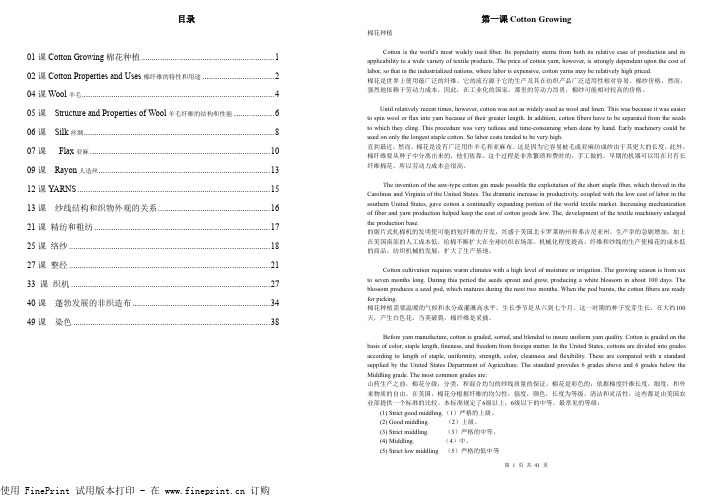
目录01课Cotton Growing棉花种植 (1)02课Cotton Properties and Uses棉纤维的特性和用途 (2)04课Wool羊毛 (4)05课Structure and Properties of Wool羊毛纤维的结构和性能 (6)06课 Silk丝绸 (8)07课 Flax亚麻 (10)09课 Rayon人造丝 (13)12课YARNS (15)13课纱线结构和织物外观的关系 (16)21课精纺和粗纺 (17)25课络纱 (18)27课整经 (21)33 课织机 (27)40课蓬勃发展的非织造布 (34)49课染色 (38)第一课Cotton Growing棉花种植Cotton is the world's most widely used fiber. Its popularity stems from both its relative ease of production and its applicability to a wide variety of textile products. The price of cotton yarn, however, is strongly dependent upon the cost of labor, so that in the industrialized nations, where labor is expensive, cotton yarns may be relatively high priced.棉花是世界上使用最广泛的纤维。
它的流行源于它的生产及其在纺织产品广泛适用性相对容易。
棉纱价格,然而,强烈地依赖于劳动力成本,因此,在工业化的国家,那里的劳动力昂贵,棉纱可能相对较高的价格。
Until relatively recent times, however, cotton was not as widely used as wool and linen. This was because it was easier to spin wool or flax into yam because of their greater length. In addition, cotton fibers have to be separated from the seeds to which they cling. This procedure was very tedious and time-consuming when done by hand. Early machinery could be used on only the longest staple cotton. So labor costs tended to be very high.直到最近,然而,棉花是没有广泛用作羊毛和亚麻布。
纺织英语第三版课后单词总结(含音标)
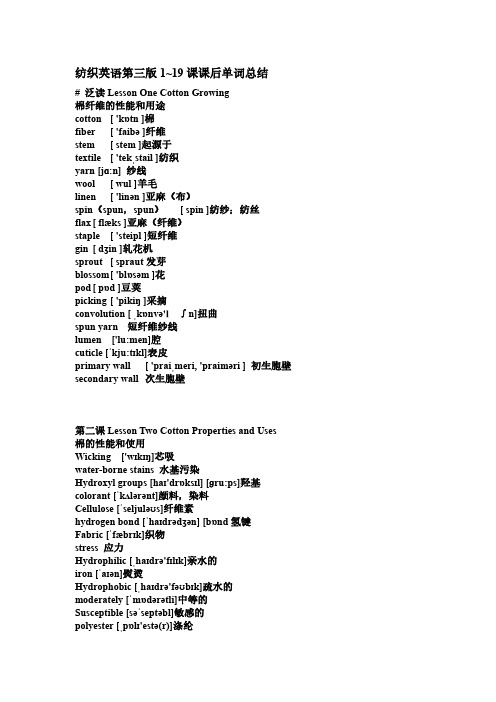
纺织英语第三版1~19课课后单词总结# 泛读Lesson One Cotton Growing棉纤维的性能和用途cotton [ 'kɒtn ]棉fiber [ 'faibə ]纤维stem [ stem ]起源于textile [ 'tekˌstail ]纺织yarn [jɑ:n] 纱线wool [ wul ]羊毛linen [ 'linən ]亚麻(布)spin(spun,spun)[ spin ]纺纱;纺丝flax [ flæks ]亚麻(纤维)staple [ 'steipl ]短纤维gin [ dʒin ]轧花机sprout [ spraut发芽blossom [ 'blɒsəm ]花pod [ pɒd ]豆荚picking [ 'pikiŋ ]采摘convolution [ ˌkɒnvə∫n]扭曲spun yarn 短纤维纱线lumen ['lu:men]腔cuticle [ˈkju:tɪkl]表皮primary wall [ 'praiˌmeri, 'praiməri ] 初生胞壁secondary wall 次生胞壁第二课Lesson Two Cotton Properties and Uses棉的性能和使用Wicking ['wɪkɪŋ]芯吸water-borne stains 水基污染Hydroxyl groups [haɪ'drɒksɪl] [ɡru:ps]羟基colorant [ˈkʌlərənt]颜料,染料Cellulose [ˈseljuləʊs]纤维素hydrogen bond [ˈhaɪdrədʒən] [bɒnd氢键Fabric [ˈfæbrɪk]织物stress 应力Hydrophilic [ˌhaɪdrə'fɪlɪk]亲水的iron [ˈaɪən]熨烫Hydrophobic [ˌhaɪdrə'fəʊbɪk]疏水的moderately [ˈmɒdərətli]中等的Susceptible [səˈseptəbl]敏感的polyester [ˌpɒlɪ'estə(r)]涤纶Organic solvent 有机溶剂homey 家庭般的Mold 霉菌mainstay [ˈmeɪnsteɪ]主要力量Fungus 真菌no-iron 免烫Prominent 突出的,显著地pillowcase枕套Mildew 发霉crisp 挺爽Degradation 降解smother 窒息Gas dryer 煤气烘干机stuff 闷热的,窒息的Impart 给予interstice 空隙Flexibility 挠性canvas gear 帆布用具Apparel 服装supplant 取代,替代Home furnishings 家居装饰cord 绳索Recreational 休闲的twine 细绳Pliable 柔顺的lash 捆绑Garment 服装bale 大包Shrink-resistant finish 防缩整理Blending 混纺# 泛Lesson Three Properties of the Naturally Colored Cottons 天然彩棉的性质disposal [ di'spəuzl ]处理,排放drainage [ 'dreinidʒ ]污水mercerize ['mɜ:səraɪz]丝光处理pesticide [ 'pestiˌsaid ]杀虫剂weed killer [wi:d]除草剂deposit [ di'pɒzit ]存留,囤积organic fertilizer [ɔ:ˈgænɪk] [ˈfɜ:təlaɪzə(r)]有机肥environmentally friendly 环境友好地breed 育种,品种color intensity [ in'tensəti ]颜色强度plantation [ plæn'tei∫n ]农场lignin [ 'lignin ]木质素pectin [ 'pektin ]果胶hydrophobic [ ˌhaidrə'fəubik]疏水的deteriorate [dɪˈtɪəriəreɪt]损害hue [hju:]色彩# 泛Lesson Four Wool 羊毛antiquity [ æn'tikwəti ]古代felt [ felt ]毡,制毡prehistoric 史前的weave [wi:v]机织,织造;做名woolen goods 粗纺毛织物scouring [ skaur ]洗毛merino sheep [məˈri:nəʊ]美利奴羊worsted fabric [ˈwʊstɪd]精纺毛织物wavy [ 'weivi ]卷曲的inoculate [ i'nɒkjəˌleit ]给接种,给注射rangeland [ 'reindʒˌlænd ]放牧场fleece [fli:s]套毛clip wool [ klip ]套毛pulled wool [ pul ]皮板毛depilatory [dɪˈpɪlətri]脱毛剂preliminary grading [ˈgreɪdɪŋ]预分等,初级分等mill [mɪl]纺织厂decompose [ˌdi:kəmˈpəʊz]分解mineral acid [ˈmɪnərəl]无机酸Lesson Five Structure and Properties of Wool羊毛的结构和性能microscopic 显微镜的commmendable值得赞扬的scale 鳞片regain恢复magnification 放大倍数crushing挤压horny角状的durable crease耐久皱褶cuticle角质层Pleat皱褶打褶cortex角质皮质cross- linkage交键cortical cell角质细胞皮质细胞poiymer高聚物medulla毛髓loft蓬松的高雅的authoraty权威机构上级机关moisture regain回潮率pigment颜料染料covering power覆盖系数micron微米desportion水分释放kemp死毛hygroscopic吸湿的elliptical椭圆形的finish织物的整理oval卵形的椭圆形的interfacial界面的felting毡化silky像蚕丝一样的yellowish-white稍微发黄的白色# 精Lesson Six Silk 丝sericulture ['serɪˌkʌltʃə]养蚕业,蚕丝业AD 公元silkworm [ˈsɪlkwɜ:m]蚕reeling ['ri:lɪŋ]缫丝,络丝cocoon [kəˈku:n]蚕茧prestige [pre'sti:ʒ]声望;名声luxury [ˈlʌkʃəri]华贵的queen of fiber 纤维皇后denier [ˈdeniə(r)]旦尼尔specific gravity 相对密度moth [mɒθ] 蛾metal salts [ˈmetl]金属盐;无机盐sputter [ˈspʌtə(r)]噼啪爆响cellulosic fiber [seljʊ'ləʊsɪk] 纤维素纤维solubility [ˌsɒljʊ'bɪlətɪ] 溶解性ammonia [əˈməʊniə] 氨水concentration [ˌkɒnsnˈtreɪʃn] 浓度fibroin ['faɪbrəʊɪn]丝心蛋白keratin [ˈkerətɪn]角蛋白scroop [skru:p]丝鸣# 精Lesson seven Flax亚麻bast fiber [bæst]韧皮纤维woody [ˈwʊdi]木质的phloem [ˈfləʊem]韧皮stalk [stɔ:k]茎stem [stem]茎,针杆temperate [ˈtempərət]温和的intact [ɪnˈtækt]未经触动的rip [rɪp]剥boll [bəʊl]植物的铃rot 腐烂retting ['retɪŋ]沤麻dew retting [dju:]露水沤麻pool retting 池塘沤麻sheaves [ʃi:vz] sheaf的复数形式捆,束stagnant [ˈstægnənt]不流动的,污浊的bacteria[bækˈtɪəriə] bacterium的复数形式细菌tank retting 池浸沤麻sodium hydroxide 氢氧化钠sodium carbonate [ˈsəʊdiəm [ˈkɑ:bəneɪt]碳酸钠dilute sulfuric acid 稀硫酸fluted roller 沟槽罗拉scutch [skɒtʃ]打麻hackle ['hækl]梳麻comb [kəʊm] 梳理(精梳)tow [təʊ] 短纤维,短麻,落纤line [laɪn]长纤维,长麻sliver [ˈslɪvə(r)] 条子,棉条,毛条,纤维条carding ['kɑ:dɪŋ]梳理(粗梳)choice fiber 上等纤维sheen [ʃi:n] 光彩,光泽resin finish [ˈrezɪn]树脂整理easy care [ʃi:n]免烫,洗可穿serviceability [sɜ:vɪsə'bɪlɪtɪ]耐用性能wicking property 芯吸效应discoloration [disˌkʌləˈreiʃən]脱色beetling finish ['bi:tlɪŋ]捶布整理laundry aids [ˈlɔ:ndri] 洗涤剂aging 老化durable-press 耐久压烫,耐久定形,免烫整理,DP整理# 泛Lesson Eight Other Bast Fibers其他韧皮纤维jute [dʒu:t]黄麻burlap [ˈbɜ:læp]粗麻布hessian [ 'he∫n ]打包麻布grayish color [ˈgreɪɪʃ]泛灰的颜色fibrous [ˈfaɪbrəs]纤维状的gummy [ 'gʌmi ]黏稠的beige [ beiʒ ]米色microorganism [ˌmaɪkrəʊ'ɔ:gənɪzəm]微生物bagging ['bægɪŋ]打包布,马岱布carpet backing [ˈkɑ:pɪt]地毯底布,地毯背衬taping [teɪpɪŋ] 贴边linoleum [lɪˈnəʊliəm]漆布olefine ['əʊləfɪn]烯烃labor-intensive [ˈleibəinˈtensiv]劳动密集型ramie ['ræmɪ] 苎麻nettle [ˈnetl]荨麻family [ˈfæməli](植物的)科,类perennial [pəˈreniəl]多年生的shrub [ʃrʌb] 灌木necessitate 需要degum [nəˈsesɪteɪt]脱胶pectin [ˈpektɪn]果胶neutralize [ˈnju:trəlaɪz]中和crystallinity [,kristə'linəti]结晶度accessibility [əkˌsesə'bɪlətɪ]可及杜nonfibrous [nɒn'ferəs]非纤维状的hemp [hemp]大麻deplete [dɪˈpli:t]耗尽nutrient [ˈnju:triənt]营养的,营养品stripping 搏麻drawing [ˈdrɔ:ɪŋ]牵伸cordage ['kɔ:dɪdʒ]绳索sacking [ˈsækɪŋ]麻第九课Lesson Nine Rayon 人造丝Rayon黏胶,人造纤维Degree of polymerization聚合度Degree of crystallinity结晶度Infrared spectrum红外光谱Native cellulose天然纤维Regenerated cellulose再生纤维素Mechanism机理Morphologically形态方面的Contaminant污染物Pulp浆粕Molecular orientation分子取向Viscose黏胶Mode方式Amorphous area非结晶区Dyeability染色性能Striation条纹Delustered消光的Bilobal双叶形的High wet-modulus高湿模量Off round偏离圆形Cuprammonium rayon铜氨人造丝Surgical外科用Wipe擦试用品Limp松软Textured yarn变形纱Acrylic腈纶Reactant反应物Starch淀粉Softener柔软剂Hypochlorite次氯酸盐Peroxide bleach过氧化物漂白剂Dyestuff 染料第十课Lesson Ten Polyester Fibers聚酯纤维DuPont 杜邦公司polyamide 聚酰胺纤维ICI(Imperial Chemical Industries Limited)英国帝国化学工业公司Dacron 大可纶drawing process 牵伸过程heat stabilization 热定型static electric charge 静电accentuate 强调,突出heat-set 热定形pilling 起球protective clothing 防护服fire hose 消防水管tire cord 轮胎帘子布per-capita 人均implant 移植allergenic 过敏的drip-dried 滴水晾干11课Lesson Eleven Fiber Identification纤维鉴定Qualitative identification 定性鉴别staining 沾污,沾色Tentativeiy 试验性地refractive index 折射率Verify 证实index of birefringence 双折射率Unravel 拆散X-ray diffraction machine X光衍射仪Forceps 镊子infrared spectrophotometer 红外分光光度计Residue 残渣chromatograph 色谱仪Fluffy 毛茸茸的polarizing microscope 偏振光显微镜Photomicrograph 显微镜照片12课Lesson Twelve Yarns 纱Align 排成一排Roving 粗纱Assembly 集合体Plied yarn 合股线Cable 粗绳索Hawser 缆Forefinger 食指Medieval 中世纪的Untwist 退捻Curl 卷曲Kink 扭结Weaver 织布工人,织造工作者Middle age 中世纪Yarn number 纱线细度Yarn count 纱线支数,纱线线密度Nomenclature 名称术语Hank 纱绞Spun-silk 绢丝Yarn size 纱线支数,纱线细度Tex 特克斯Lesson Thirteen Relationship between Yarn Structure and Fabric Performance 纱线结构和性能间的关系crimp 英[krɪmp] 卷曲scatter 英['skætə(r)] 消散Overtwist英['əʊvətwɪst]强捻ridge 英[rɪdʒ]凸棱concomitant英[kən'kɒmɪt(ə)nt]伴随的bulk 英[bʌlk]蓬松的tweed 英[twiːd]粗花呢jacket 英['dʒækɪt]夹克bulky 英['bʌlkɪ] 粗大的,肥壮的blouse 英['blaʊz] 女衬衫,罩衫barrier英['bærɪə]阻挡层sultry 英['sʌltrɪ] 闷热的clammy英['klæmɪ黏糊糊的hairiness ['hɛrɪnɪs] 毛羽shed soil 英[ʃed sɒɪl阻挡尘土snag 英[snæg] 钩丝unsightly 英[ʌn'saɪtlɪ]不雅观的texture 英['tekstʃ质地slick英[slɪk] 滑溜溜的fuzzy 英['fʌzɪ] 毛茸茸的pajamas 英[pə'dʒɑːməz] 睡衣Acetate fiber 英['æsɪteɪt 'faɪbɚ]醋酯纤维satin 英['sætɪn]经面缎纹highlight 英['haɪlaɪt重点突出lining英['laɪnɪŋ]衣服衬里disrobe 英[dɪs'rəʊb]脱衣diffuse英[dɪ'fjuːz] 扩散,漫射第十四课Lesson Fourteen Staple Fiber Spinning(1)短纤维纺纱opening 开松cleaning 除杂carton 纸板箱opener 开棉机,开松机blender 混棉机,混合机intermittent system 间歇式纺纱系统spike 置凸钉apron 皮圈,皮板输送带lattice 输送帘子hopper 料斗,棉箱conveyor belt 传送带picking unit 清棉装置picker 清棉机forced air 高压气流picker lap 清棉棉卷card unit 梳理机构ring-spun yarn 环锭纱tuft 簇,团carding frame 梳棉机,梳理机drawing frame 并条机wire card 钢丝梳棉机granular card 无盖板梳棉机,微粒梳棉机card clothing 针布wire flat 盖板tease 梳理cylinder 锡林,滚筒doff 落卷,落筒can 条筒combed yarn 精梳机carded 粗梳机breaker-drawing 头道并条15课Lesson Fifteen Staple Fiber Spinning(2) Roller 罗拉roving frame 粗纱机Lapper 成网机,成网机构attenuate 使变细Comber 精梳机bobbin筒管Finisher-drawing 末道并条spinning frame 细纱机Assemblage 集合体ring spinning 环锭纺纱Draft 牵伸spindle 锭子Traveler 钢丝圈single 单纱Ring 钢领,环状,环形物# 泛Lesson Sixteen Textured Yarn膨松纱slippery [ˈslɪpəri]滑溜溜的(但没有弹性)full 丰满的handle [ˈhændl]手感linear density [ˈlɪniə(r)] [ˈdensəti]线密度extensibility [ɪksˌtensə'bɪlɪtɪ]伸展性bending stiffness ['bendɪŋ] [stɪfnəs]弯曲刚度disposition [ˌdɪspəˈzɪʃn]布置thermosetting ['θɜ:məʊˌsetɪŋ]热定型kont-free 无结complement [ˈkɒmplɪment]补充cover factor 覆盖系数offset [ˈɒfset]抵消stretch yarn 弹力丝,弹力纱false twist [fɔ:ls] [twɪst]假捻bulked yarn [bʌlk]膨体纱carpet [ˈkɑ:pɪt] 地毯,毛毯hosiery [ˈhəʊziəri]针织品,袜类stuffer-box 填塞箱air-jet 气流Lesson Seventeen Open-end Spinning自由端纺纱open-end spinning自由端纺纱,转杯纺纱warping ['wɔ:pɪŋ]整经synonym [ˈsɪnənɪm] 同义词fiber migration纤维迁移break spinning 自由端纺纱,转杯纺纱technique 差异染色技术rotor spinning 转杯纺纱spinning 涡流纺纱sieve 筛网wash-and-wear 洗可穿rotor 纺纱杯# 泛Lesson Eighteen Some specially Formed Yarns特殊成纱friction spinning [ˈfrɪkʃn [ˈspɪnɪŋ]摩擦纺纱DREF spinning 德雷夫纺纱法,尘笼纺body 身骨self-twisted yarn 自捻纱selfil yarn 加长丝自捻纱twistless yarn 无捻纱core-spun yarn 包芯纱spandex ['spændeks氨纶,斯潘德克斯弹性纤维coverspun 包绕纺纱bicomponent ['bɪkəmp'əʊnənt]双组分supple [ˈsʌpl]柔软的# 泛Lesson Nineteen Stretch Yarns and Fabrics弹力丝和织物terminology [ˌtɜ:mɪˈnɒlədʒi]术语,专用名词elastomeric [ɪˌlæstə'merɪk]弹性的braid [breɪd]编织foundation garment [ˈgɑ:mənt]全帮,内衣surgical supplies [ˈsɜ:dʒɪkl] [səp'laɪz]外科手术用织物knife-edge 刀口back twisting 反向加捻cross-linking resin 交联树脂kinky ['kɪŋkɪ]纽结的springy [ˈsprɪŋi]有弹性的cellulose eater [ˈseljuləʊs] [ˈi:tə(r)]纤维素酯cellulose ether [ˈi:θə(r)]纤维素醚thermoplastic [ˌθɜ:məʊˈplæstɪk]热塑性的knotting ['nɒtɪŋ]打结,编结piece-goods stretch 匹布加弹slipcover ['slɪpˌkʌvə]家具套,沙发套therapeutic [ˌθerəˈpju:tɪk]治疗的support hose [səˈpɔ:t həuz]管状弹性绷带。
- 1、下载文档前请自行甄别文档内容的完整性,平台不提供额外的编辑、内容补充、找答案等附加服务。
- 2、"仅部分预览"的文档,不可在线预览部分如存在完整性等问题,可反馈申请退款(可完整预览的文档不适用该条件!)。
- 3、如文档侵犯您的权益,请联系客服反馈,我们会尽快为您处理(人工客服工作时间:9:00-18:30)。
Lesson Twelve第12课Yarns纱线Spinning is the oldest method of manufacturing yarn. The process requires aligning a bundle of staple fibers, pulling them out into a rope, known as a roving, and further pulling out and twisting the roving to form the yarn. The product of the spinning operation is a twisted assembly of fibers that is strong and flexible. The yarn is stronger than the individual fibers since the fibers act in concert to support a load. Single yarns may be twisted together to form an even stronger yarn, These plied yarns may be plied again and again to make thicker and stronger cords, cables, rope and hawsers.纺纱是制造纱线最原始的方法。
纺纱过程要求一束短纤维排成一线,将他们拉入一对罗拉中,例如粗纱,继续拉伸并加捻粗纱形成纱线。
细纱工序的产品是一束具有一定强度和挠曲性的加捻纤维集合体。
纱线比其包含的纤维的联合强度要大,因为纤维通过联合作用共同承担外界负荷。
单根纱线可能被放在一起加捻以形成更高强力的纱线。
这些合股线可能被一次又一次的合股以形成更厚重强力更大的粗绳索。
Yarns, cords, and cables may be twisted in either S or Z direction. An S-twist yarn is one in which the fibers follow a spiral pattern parallel to the center bar of the letter S. In a Z-twist yarn the fibers are parallel to the center bar of the letter Z. Often yarns are too fine to allow the unaided eyes to discern the twist direction. However, if you hold a short length of yarn vertically in your left hand and rotate it between the thumb and forefinger of your right hand while pulling upward, you can determine the twist direction. When it is rolled clockwise by your right hand, an S-twist yarn will become tighter and a Z-twist yarn looser. The direction of the twist does not affect the yarn’s performance. However, it is customary to produce cotton and linen yarns with a Z-twist and woolen and worsted yarns with an S-twist. This custom has its roots in medieval consumer protection laws; consumers could easily find out whether a cloth was really wool by simply untwisting one of the yarns and checking the direction of the twist.这些粗绳可能被加上S捻,也可能被加上Z捻。
S捻的纱线中的纤维成螺旋状并与字母S 中间的斜杠平行。
在Z捻的纱线中,纤维与字母Z中间的斜杠平行。
纱线通常因为太细使得肉眼很难识别其捻向。
然而,当你用左手竖直的拿着一小段纱线,再用右手的拇指和食指夹住纱线的另一头,一边向上拉,一边旋转,这时你就可以测出它的捻向了。
如果你用右手顺时针的旋转它,S捻的纱线会越变越紧,Z捻的纱线会越变越松。
加捻的方向不会影响纱线的外观。
然而,人们习惯性的生产棉和亚麻纱线时用Z捻,生产羊毛和精纺毛料纱线时用S捻。
这种习俗起源于中世纪的消费者保护法;消费者可以仅仅通过退捻纱线,检查纱线捻向,从而轻易地确定布料是否是真正的羊毛所制。
As the yarn is twisted, internal forces are built up in the direction of the twist. Theseforces are known as torque. In general, each turn adds the same amount of torque to the yarn, so yarns with the same number of turns per meter have about the same amount of torque. Since the torque is approximately proportional to the tpm ( turns per meter ), we may illustrate the formation of balanced and unbalanced yarns by counting the turns per meter. Start with a pair of single yarns having 200 tpm in the S direction. Twist them together with another 100 tpm in the S direction .The internal torque on each of the singles will be about 300 tpm , while torque on the two-ply yarn will be 100 in the S direction. This yarn will be unbalanced, and will curl. If the same two single are plied into a double by twisting 100 tpm in the Z direction, the counterclockwise twist will tend to unwrap the single yarns and the internal torque of the single yarns will be reduced to 100 in the S direction. The external torque will be 100 in the Z direction. The internal and external torques balance each other and the yarn will be balanced. It is important to the manufacturer that the yarn be balanced during cloth construction because the kinks and curls that may be formed by unbalanced yarns will become entangled in the machinery and cause imperfections in the product. This simple analysis holds only for two-ply yarns. More complicated structures, such as cords and cables, require a more sophisticated approach.当纱线被加捻的时候,在捻度的方向上也会相应地形成内应力。
这种力被称为扭转力。
通常,纱线每转一圈,都会增加相同的扭转力,所以每米具有相同转数的纱线就会具有相同的扭转力。
既然扭转力和每米纱线所具有的转数(tpm)近似成正比,因此我们通过数出纱线每米的转数来说明平衡纱线和非平衡纱线的形成原理。
以一对200tpm的S捻向的单纱为例。
用另外的100tpm的S捻将两个单纱加捻到一起。
每根单纱的内部扭转力就达到了300tpm,然而合股线在S捻方向上的扭转力是100tpm。
这时纱线则不平衡,将会形成卷曲。
如果给相同的两根单纱加上Z方向上100tpm的捻度使它们合成一股时,逆时针方向的加捻则会使单根纱线易于解开,使其在S捻向上的内部扭转力降到100。
合股线在Z捻向上的外部扭转力将达到100。
内外扭转力之间相互平衡使得纱线保持平衡。
对于制造商来说,布料结构中纱线的平衡是相当重要的,因为不平衡的纱线所形成的扭结和卷曲将会被缠在机器里引起产品的瑕疵。
这些简单的分析只适合于由两根单纱合股成的纱线。
像绳索这些更复杂的结构则需要更精确地探索。
Most of the yarns used in household and apparel are cords or smaller. We shall, therefore, concentrate on these types.用于家具和服装的大部分纱线都是粗线或稍微细些的线。
因此,我们应该把精力放在这种类型的研究上。
From the beginning weavers and other users of yarn needed a standard way to designate the various yarn types accurately, so that buyers and sellers could reach mutual understanding.During the early Middle Ages, a system of yarn numbering was devised. This system, still in use today, is known as the yarn number or yarn count. ( Note that “yarn count” also designates the number of ends and picks in a woven cloth. Be aware of this overlap in nomenclature and don’t confuse the two applications.) Yarn number is defined as the number of standard hanks per pound of yarn. What is the standard hank? It varies with the fiber. Cotton and spun-silk yarns are measured by an 840yd (768m) hank; worsted ( a fine wool yarn) is measured by the 560yd (512m) hank; linen andstandard wool yarns are measured by the 300yd (274m) hank. The lengths of the standard hanks were chosen as convenient values for the yarn sizes in use at the time the system was devised.首先,织布工人以及其他的纱线使用者需要一个标准的方法去精确的标明各种不同类型的纱线,以便于买卖双方能够达成一个相互的认同。
